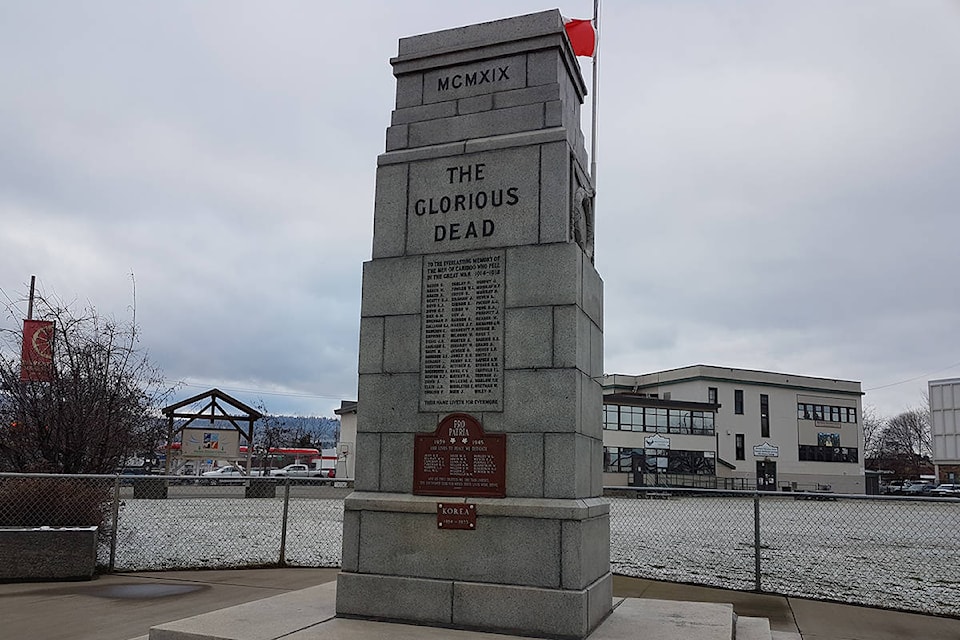Remembrance Day has been observed around the world since Nov. 11, 1919, exactly a year following the signing of the armistice of Nov. 11, 1918, which led to the official end of the First World War on 28 June, 1919.
In Quesnel, one of the many ways we remember those who have fought in the war is by paying tribute at the local Cenotaph.
The Quesnel Legion has provided the Observer with a copy of research done by the late Tom Moffat, which identifies each of the names on the Cenotaph from the First World War and attempts to find out who they were and how they died. In doing this, Moffat referenced a number of primary and secondary sources. The Quesnel Cariboo Observer featured prominently in his research.
READ MORE: Tom Moffat honoured with Lifetime Achievement Award
Here are a few of the stories Moffat was able to compile:
Archie Arthur Boyd: L/Cpl. Archie Arthur Boyd, of Cottonwood House, was the son of John Boyd and Janet Fleming Boyd. He enlisted in Sept. 1915, and was killed in action on April. 9, 1917 in the Battle of Vimy Ridge at age 30.
According to articles in the Observer in May and June of 1917, Boyd was “shot through the heart while his company was charging, being killed instantly, and was buried two days later on the spot where he met his gallant end.” Two of his friends, Walter and Chester, were alongside him when he was killed.
Jack Hugh Ellis: Cpl. Jack Hugh Ellis, the son of Sam and Harriet Ellis, was a Barkerville man. He enlisted in Aug. 1915, and was at the front for nearly nine months when he was killed. He also spent six weeks in the Battle of the Somme.
Ellis was wounded in No Man’s Land, and then gassed upon taking cover. Ellis was just 25 years old.
James Edward Graham: Pte. James Edward Graham enlisted in the fall of 1915 with the 67th Western Scots. According to a May 1918 edition of the Observer, Graham received the Croix de Guerre (Belgian). The medal is awarded for bravery on the battlefield for his “conspicuous gallantry and devotion to duty during the recent Ypres operations.” Graham was killed in action on Oct. 28, 1918.
William Carrall Hilborn: Capt. William Carrall Hilborn, the son of Stephen and Elizabeth Hilborn, joined the Royal Flying Corps in the summer of 1917, He served in Italy. He later transferred to the 45 Squadron, where he was fatally injured three days later and died on Sept. 26, 1918. He was 20 years old.
Hilborn was awarded the Distinguished Flying Cross (DFC) 10 days earlier, for his work as a patrol leader and his display of courage, endurance and skill. He took out at least six enemy aircraft during his time in the war.
Fredrick Vivian Knox: Cpl. Fredrick Vivian Knox, son of John A. and F. E. Knox, enlisted in May, 1915. Knox was killed by a bombing whilst participating in a night raid on Nov. 21, 1916.
According to an article in the Observer in Dec. 1916, Knox was leading his own squad in the raid, and in the midst of calling to his comrades when he was “struck by a bomb and was instantly killed.” His comrades brought his body back to their lines, and the next day, all of his comrades who were not injured in the raid buried his body in the cemetery with “full military honours.” He was 30 years old.
James McLeese: Pte. James McLeese, the son of John and Matilda McLeese of 150 Mile House, was killed in the Battle of Passchendaele.
According to an article in the Observer in December, 1917, McLeese was killed while taking water up to the front lines in “one of the worst places ever” when he was hit by a bursting shell. He was posthumously awarded the Military Medal, for his “conspicuous bravery in getting the rations up.” McLeese was 25 years old.
Alfred James Pickup: Pte. Alfred James Pickup, of Barkerville, was a member of the 2nd Battalion of the Yorkshire Regiment. According to an article in the Observer in Jan. 1915, “when the war broke out …[Pickup] threw up his job and went to England at once.” He was killed in action on Sept. 26, 1915.
Tom Moffat’s full research of each name listed on the Cenotaph’s World War I plaque is available on request at Quesnel’s Royal Canadian Legion Branch 94.
The Quesnel Cenotaph also recognizes veterans of World War II, the Korean War, the war in Afghanistan, the Persian Gulf War and peace time veterans.
heather.norman@quesnelobserver.com
Like us on Facebook
